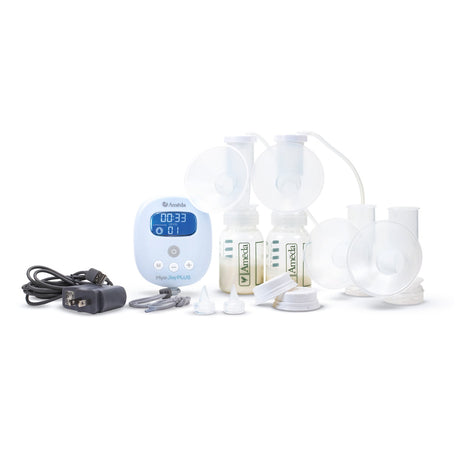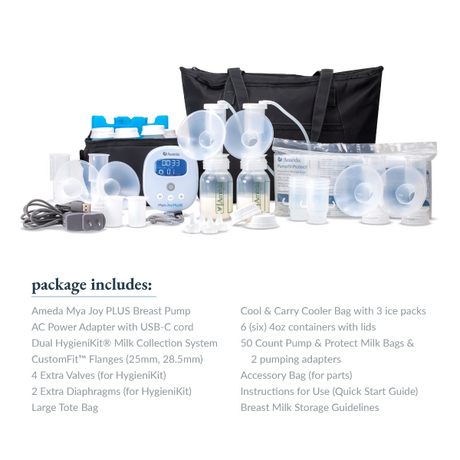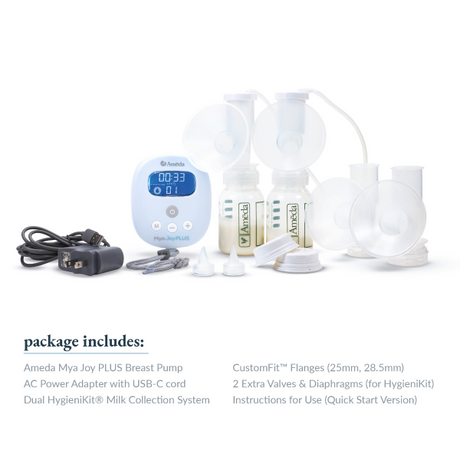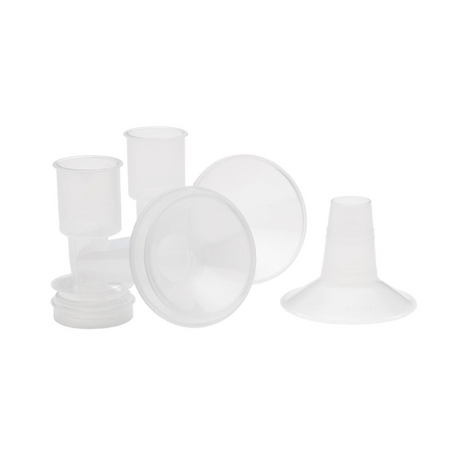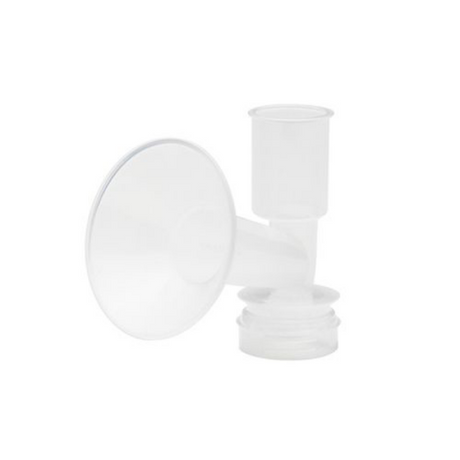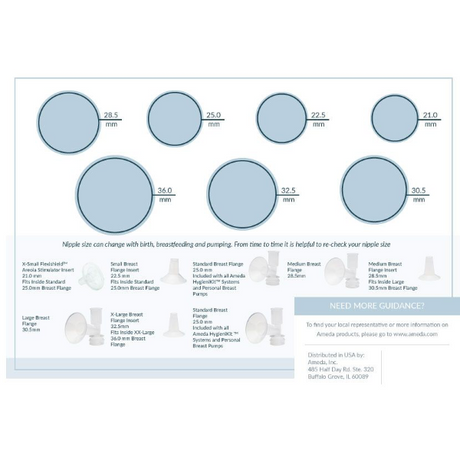Published:
When you can’t be there, your breast milk still can be if you use a breast pump. A good breast pump is essential to maintaining your milk supply when you are separated from your baby or if your baby is too premature or sick to breastfeed.
Reasons to Pump Breast Milk
There are many reasons to pump breast milk.
Being Apart from Your Baby
- Pump if your baby is too premature or sick to breastfeed, but you want to provide your breast milk for her feedings. Breast milk is nutritious and healthy and may help your baby develop so you can go home from the hospital sooner.
- Pump if you will be apart from your baby for some of her feedings due to work, school, or other reasons.
Pumping when you are apart from your baby helps your baby receive the benefits of breast milk, helps you avoid the expense of formula, and gives you flexibility to be apart from your baby.
Breast Issues
- Sometimes a mother’s breast becomes too full for her baby to latch on easily. Pumping for a few minutes may soften your breast, areola, and nipple enough so the baby can latch on more easily.
- If you have flat or inverted nipples, it may be more difficult for your baby to latch on. Using a breast pump for a few minutes may help pull out your nipples, which may make it easier for your baby to take the breast.
Milk Supply Issues
- If you’re having trouble making enough milk, using a breast pump may provide additional breast stimulation that will help you increase your milk production. Pumping to drain your breasts of milk more completely more times each day helps you make milk faster. To learn more about how breasts make milk, click here.
Choosing a Breast Pump
There are a variety of breast pumps on the market today. But before you choose a pump, it’s helpful to know what features to look for.
Multi-User Breast Pumps
Ameda multi-user pumps are a great choice for any mom! They are specifically recommended when a baby is not yet breastfeeding, because they are clinically proven to help establish full milk production (link to clinical pages on each pump) . These pumps are used when babies are born preterm, sick, or are not breastfeeding for other reasons. Multi-user pumps can be shared. Each mother attaches her own milk collection kit to the pump, which keeps her milk separate from other milk. Ameda multi-user pumps allow for both single and double pumping. Additionally, a pump with two separate controls (suction and speed) is ideal. More setting choices helps you find what works best for you.
Ameda has two multi-user pumps. Click to learn more about their specific features and benefits.
Personal Electric Breast Pumps Ameda’s personal electric breast pumps are designed to be used by one mother. They are the best choice for mothers who have full milk production and are absent at feedings due to work, school, or other activities outside the home. Ameda personal pumps also allow for both single and double pumping. Likewise, Ameda personal pumps have separate controls to give you more customizable speed and suction options. (start here)
Single-user pumps vary widely in quality. Additional features to look for are:
- Durability. Most pumps designed for daily use offer a one-year warranty on the motor.
- Flange Fit Options. With pumping, nipple size and elasticity can change. For greater comfort over time, a range of sizes will allow you to change flanges as your body changes.
- Adjustable Suction and Speed. The more adjustable your pump, the easier it is to follow your milk flow and find your own best settings (within safe and effective suction and speed ranges). Pumps with one control are less adjustable than those with two separate controls.
- Power options. More power options means you can pump in more places. Look for a pump that can be run by batteries, a car adapter, and an AC adapter.
- Pump Care. Easy care is important. Count how many parts need to be washed and whether the narrow, hard-to-clean tubing ever needs to be cleaned.
Ameda has a number of single-user, personal electric breast pumps with a variety of accessories. Click to learn more about their specific features and benefits.
Manual Breast Pump
Most manual pumps are powered by squeezing a handle. A manual pump is a good choice if you plan to miss breastfeedings no more than once a day. They require practice to find the rhythm that most quickly triggers milk flow. A manual pump may also be a good back-up option in case of power issues.
Ameda has manual breast pump offerings. Click to learn more about specific features and benefits.
Using a Breast Pump
Get ready to pump in just a few easy steps.
Choose the Correct Flange Size for You The flange is the piece held to your breast during pumping. Every mother needs a good breast flange fit for greater comfort and better milk flow. What determines a breast flange’s size – and your fit – is the width of its opening. To check your breast flange fit, watch your nipple during pumping. Use the pictures below as a guide.

Good Fit: During pumping, your nipple moves freely in the breast flange tunnel. You see space around the nipple. Not much areola is drawn into the tunnel with the nipple.

Too Small: During pumping, some or your entire nipple rubs against the sides of the breast flange tunnel.

Too Large: During pumping, more areola is drawn into the breast flange with your nipple. Your areola may rub against the side of the breast flange tunnel. Breast flange fit can change with birth, breastfeeding, and pumping. The breast flange that fits you well when you started pumping may need to change with time. Recheck your breast flange fit from time to time.
Prepare to Pump
Learning to pump can be a daunting process. It will get easier with time and practice.
- Read your breast pump instructions.
- Always wash hands well with soap and water before handling the product.
- Assemble the kit.
- Attach the kit to the pump.
- Center the breast flanges over your nipples. Press them lightly against your breasts to make an air seal.
- If you’re double pumping, position your arm to hold both flanges against your breasts, maintaining an air seal. If you want to single pump, close off an adapter port per the instructions for use.
Turn the Pump On
- Ameda Purely Yours®/LactalineTM: Turn the suction dial to the right to turn on the pump.
- Ameda EliteTM: Turn the vacuum dial to the right to turn on the pump.
- Ameda Platinum®: Push the power button on.
Set the Dials for Comfort and Milk Flow
- Set suction/vacuum for comfort. Set SUCTION/VACUUM to the highest setting that feels comfortable and no higher. The strongest pump suction does not always pump more milk. You can increase the suction as your milk starts to flow and you become used to the pump, but remember, pumping should never hurt. Your body doesn’t release milk well when you are in pain.
- Set speed/cycles for comfort and milk flow. Set SPEED/CYCLES to the fastest setting when you start pumping. This will stimulate your breasts to release oxytocin, which causes a milk ejection reflex (let-down). This release causes milk to be squeezed out of the alveoli, into the ducts and out of your nipple into the flange.
- Once the milk is flowing, slow down the SPEED/CYCLES to keep the milk flowing. When the milk flow slows to a trickle or drip, return to the fastest setting until you trigger another milk ejection reflex, then slow the SPEED/CYCLES down again. This fast/slow pattern can be repeated several times to help drain your breasts. (This simulates how a baby sucks when she is breastfeeding: fast to get the milk flowing, then slow to draw the milk out and drain the breast.)
Stimulate the Milk Ejection Reflex (MER) When Pumping
The Milk Ejection Reflex (MER) is the process in which the hormone oxytocin triggers glandular tissue or alveoli in the breast that stores milk to squeeze, thereby causing the stored milk to lower into the ducts that transport milk, and out of your nipples.
Some mothers feel tingling during milk ejection reflex, others feel nothing and just see the milk flow start. While breastfeeding, most mothers have three or four MERs without even knowing it. Try to stimulate more than one MER when you are pumping; it will help you drain your breasts.
A MER can happen with a touch at the breast, hearing a baby cry, or even by thinking about your baby. Pain or feelings of stress, anger, and upset can block the milk ejection reflex. So, try to relax and use your mind and senses to stimulate a MER:
- Mind: Close your eyes, relax, and imagine your baby breastfeeding.
- Sight: Look at your baby or your baby’s photo.
- Hearing: Listen to a recording of your baby cooing or crying. If you’re apart, call and check on your baby.
- Smell: Smell your baby’s blanket or clothing.
- Touch: Apply a warm cloth or gently massage your breasts.
- Taste: Sip a favorite warm drink to relax you.
One or two senses may work better than the others, so test them all to find out which work best for you.
If you’re pumping with a manual pump like the Ameda One-Hand Breast Pump, you can do the same by using both fast and slow squeezes. Again, watch your milk flow and use it as your guide. Instead of double pumping, you will be single pumping (one side at a time). Change which breast you are pumping every 5-7 minutes for a total of 20 to 30 minutes.
To learn more about breast pumping and breastfeeding, check out these articles:
- Breast Pumping Guide: When and How Long to Pump
- Breastfeeding at work
- How to store breast milk safely
- Benefits of Breastfeeding
This is general information and does not replace the advice of your healthcare provider. If you have a problem you cannot solve quickly, seek help right away. Every baby is different. If in doubt, contact your physician or healthcare provider.



